

 |
 |
 |
| Separation & Ejection | Journal Home Page | Daylight Star Check |
Corrected Transcript and Commentary Copyright © 2008-2009 David Woods and Andrew Vignaux. All rights reserved.
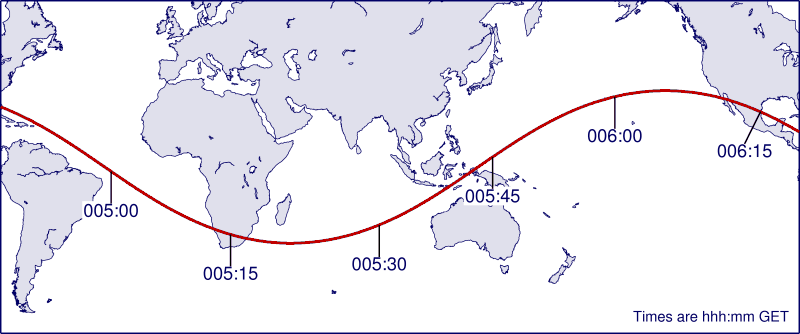
[The docked spacecraft combination of CSM and LM have separated from the S-IVB and are currently station-keeping an estimated 1000 feet (300 m) from the stage. The ground has commanded the S-IVB to execute a 62 second burn and the crew and ground are waiting for ignition scheduled to occur about 25 seconds after the start of the fourth revolution.]
Public Affairs Officer - "Ignition reported."
[S-IVB ignition occurred at 004:45:55.54 according to the Saturn V Evaluation Report.]
004:46:03 Roosa: We show ignition on the S-IVB.
004:46:06 Schweickart: It's on the way.
[The crew film the ignition of the S-IVB and about ten seconds of the departing stage with their 16mm data acquisition camera.]
004:46:15 McDivitt: It's just like a bright star disappearing into the distance.
004:46:24 Roosa: Is there quite a bit of debris kicked out there, Apollo 9?
004:46:28 McDivitt: Looked like a real clean burn.
004:46:29 Schweickart: You could see a lot of stuff coming out when he just started up, but then it just went into a nice bright light.
004:46:37 Roosa: Beautiful!
004:46:39 Schweickart: We got some movies, but I'm not sure they're going to be too good. He's pretty far out there.
Public Affairs Officer - "Apogee is 1200 miles [2200 km] now."
Public Affairs Officer - "Shutdown. Normal shutdown."
[The S-IVB engine cutoff occurred at 004:46:57.60 according to the Saturn V Evaluation Report].
004:47:10 Roosa: And the S-IVB has shut down, Apollo 9?
004:47:15 McDivitt: Roger. He's just a speck in the distance right now.
004:47:18 Roosa: Okay. Now that we've got him out of the way, back with the business at hand. I'm ready to read SPS-1 PAD any time.
004:47:27 McDivitt: Okay. Stand by just a minute. [Long pause.]
004:47:52 Roosa: Apollo 9, this is Houston. Could we have P00 and Accept? We'd like to start you up a target load.
004:47:59 Scott: Roger. You got it.
004:48:01 Roosa: Understand. We got it.
004:48:02 Scott: Roger.
004:48:10 McDivitt: Okay, Houston. Ready to copy the P30.
[The crew will copy the PAD into the following fields (cropped from the form in the flight plan).]
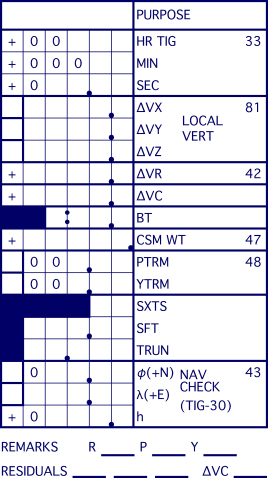
004:48:13 Roosa: Roger. Starting with the P30, and there will be about a minute delay on the target load. We're going to switch stations. Starting now on the maneuver PAD. SPS-1, 005:59 all zips, plus 0036.8 all zips, all zips, 0036.8 0032.4 0:05.1 58840, plus 1.00 minus 0.20 17 13.
004:49:23 Scott: Houston, Apollo 9.
004:49:27 Roosa: Go, Apollo 9.
004:49:30 Roosa: Go, Apollo 9.
[Communications have been switched to Antigua.]
004:49:31 Scott: Roger. You cut out very badly in that. I got Tig and I got ΔVx and ΔVr and ΔVc and that's all I got.
004:49:41 Roosa: Okay. We'll try you again, Now are you reading me, okay?
004:49:48 Scott: Roger. Reading you okay now. Stand by just a minute.
004:50:00 Scott: Okay. Go ahead again.
004:50:03 Roosa: Say again, Apollo 9.
[The technical transcription records this as "Roger again".]
004:50:05 Scott: Roger. Go ahead with your PAD.
004:50:09 Roosa: Okay, I won't read the Tig again. That's 5:59:00, and reading the ΔVx, plus 0036.8, and are you with me?
[The PAO transcription records this as "are you with us?".]
004:50:25 Scott: Yes I am, and that's as far as we got last time.
004:50:28 Roosa: Okay. All zeros for ΔVy, all zeros 0036.8 0032.4 0:05.1 58840, plus 1.00, minus 0.20 17 135.20 33.100.
004:51:16 Scott: Houston, Apollo 9.
004:51:18 Roosa: Go, Apollo 9.
004:51:20 Scott: Roger. The last thing I got was 58840; you got any more?
[The PAO transcription records this as "the last thing I got was 937.".]
004:51:23 Roosa: Roger. We'll try you again here. Stand by one here.
004:51:54 Roosa: Okay. Apollo 9, Houston. How do you read?
004:51:58 Scott: Reading you five-square, Houston.
004:52:00 Roosa: Okay. You're coming in a little weak. Understand you got up through CSM weight; is that affirmative?
004:52:07 Scott: That'a affirmative.
004:52:09 Roosa: Okay. Reading Pitch Trim: plus 1.00, minus 0.20 17 135.20 33.100. End of the PAD.
004:52:29 Scott: Roger. Readback: 005:59 all zips, plus 0036.8 all zips all zips 0036.8 0032.4 0:05.1 58840, plus 1.00, minus 0.20 17 135.20 33.100.
004:53:03 Roosa: Houston confirms the PAD. I would also now like to give you your gimbal angles used in the PAD REFSMMAT for SPS-1.
004:53:14 McDivitt: Go.
004:53:16 Roosa: Roger. It's roll 00, pitch 359, yaw 001.
004:53:30 McDivitt: Roger. Understand, 000 359 001.
[The Service Propulsion System burn #1 will be a short burn to improve orbital lifetime and to demonstrate the stability of the CSM digital autopilot. It will also be a check of the dynamics of the docked spacecraft before the longer burns on Day 2. This burn will be posigrade (in the direction of the orbit) and in the plane of the orbit. The burn is predicted to increase the apogee to 126 nautical miles (233 km).
An interpretation of SPS-1 PAD is as follows:
Purpose: SPS-1
Time of ignition, Tig (Noun 33): GET 005:59:00.00
Change in velocity, ΔV (Noun 81): x: +36.8 ft/s [11.2 m/s], y: 0.0, z: 0.0. The (local vertical) velocity components of the maneuver.
Total change in velocity, ΔVr (Noun 42): 36.8 ft/s [11.2 m/s]. The magnitude of the velocity change vector.
Velocity change counter, ΔVc: 32.4. The change set into the EMS ΔV counter.
Burn time: 5.1 seconds.
CSM weight (Noun 47): 58,840 pounds (26,689 kg).
Pitch and yaw trim (Noun 48): +1.00° in pitch, -0.20° in yaw. The SPS engine will be aligned to these angles.
Sextant star: Star 17 (Regor, Suhail, or Gamma Velorum) visible in the sextant when the shaft angle is 135.2° and the trunnion angle is 33.1°. This is used to verify the spacecraft attitude.
Tig-30 navigation check: Not required for this PAD.
Gimbal angles at Tig: Roll: 0°, Pitch: 359°, Yaw: 1°.]
004:53:35 Roosa: And this is affirmative; Houston confirms.
004:53:40 McDivitt: Roger.
004:53:42 Schweickart: And is the computer ours? Did you get the P27 in?
004:53:47 Roosa: The computer is yours, Apollo 9.
004:53:50 Schweickart: Roger. Thank you.
Public Affairs Officer - "This is Apollo Control at 4 hours, 54 minutes. Antigua has LOS now. The next station will be Ascension in about 6 minutes. You heard the crew's reaction to the S-IVB restart during this pass. An initial look at telemetry on this S-IVB burn, this second burn of the S-IVB in this mission shows an apogee of 1,680 nautical miles [3110 km], perigee of 108 nautical miles [200 km]; very early readout on it. We had predicted 1722 [nautical miles, 3190 km] by 109 [nautical miles, 202 km] . A preliminary velocity achieved, 27,763 [ft/s, 8,462 m/s] total; we were about 25,5[00 ft/s, 7,770 m/s] when we started the burn. Preburn we had expected something a total velocity of about 27,800 [ft/s, 8473 m/s]. We passed up the maneuver updates for the first service propulsion system burn in the docked configuration. This will come at 5 hours, 59 minutes into the mission; Delta V at 36.8 feet per second [11.2 m/s], duration of the burn, 5.1 seconds. The second S-IVB restart will come within 7 or 8 minutes after this first SPS burn. At 4 hours, 56 minutes, this is Mission Control Houston."
[Long comm break.]
[Communications have been switched to Ascension Island.]
Public Affairs Officer - "This is Apollo Control, we are at Ascension now."
005:02:38 Roosa: Apollo 9, this is Houston through Ascension.
005:02:43 Scott: Roger, Houston. This is Apollo 9. Reading you loud and clear.
005:02:46 Roosa: Roger, Apollo 9. We'd like to update your state vector again, if you could give us P00 and Accept.
005:02:57 Scott: Roger. You have P00 and Accept.
005:03:00 Roosa: Roger. And a couple of items: There is a bias in your X-[axis] PIPA, and we are taking a look at this. The only steps we would like to do at this time would be to recommend that you stay in average G as little time as possible. We are estimating that during the SPS-1 burn, there will be an error of about a foot and a half, and so the only thing we will do at this time is you just come out of average G as soon as possible, and we will talk about this later after the burn.
[The PIPAs (Pulsed Integrating Pendulous Accelerometers) measure the acceleration forces in each axis. The accelerometers may drift in terms of accuracy but the drift can be determined in pre-flight qualification testing and the computer can make allowances for this drift by applying a small bias to the data provided by the PIPAs.
Figure 8.6-31 in Apollo 9 Mission Report (reproduced below) shows the history of the X-axis accelerometer bias in the months prior to the flight. The last four data points show evidence of the negative trend which continued to the final inflight value of -0.53 cm/s2.
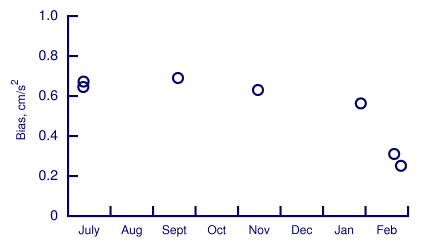
Figure 8.6-32 shows the X-axis accelerometer bias measured during the flight.
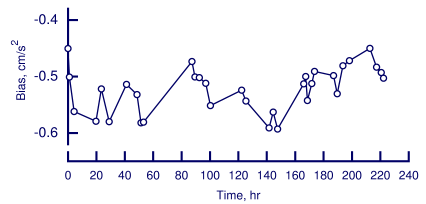
The X-axis bias was the cause of the larger than expected difference between the orbital parameters determined onboard the spacecraft (reported to the ground at 000:11:17) and the ground tracking information. This issue will be discussed further at 007:18:48 and the computer's bias compensation will be updated around 020:49:25.
005:03:37 Scott: Okay. And we have another problem here. Our O2 flow high light continues to come on and we seem to have a steady-state flow around 7-8/10 pounds per hour. We don't have the vent open yet - the waste management vent, but we do have the LM pressurization on, and I'm wondering if you could give us a clue as to whether you think we have a leaky LM or what.
005:04:07 Roosa: Roger. We copied the transmission, Apollo 9. And stand by for some words of wisdom on that.
005:04:17 Scott: We're getting the Master Alarm light on every few minutes here, either from the hydrogen-cryo or the O2 flow high. It is almost like the simulator.
005:04:30 Roosa: Roger. That is a shame. [Long pause.]
005:04:44 Roosa: Apollo 9, Houston.
005:04:48 Scott: Go ahead.
005:04:49 Roosa: Roger. We'd like to have the fans in H2 tank 1 turned on manually at this time, and just leave it on. We will leave it on for a while and take a look at it.
005:05:01 Scott: Okay. Very good. We'll turn the fan on.
005:05:03 Roosa: Okay, And we would like to know if you can see the docking angle index when you were up in the tunnel.
005:05:11 Scott: Negative. I didn't look.
005:05:14 Roosa: Okay.
005:05:35 Roosa: Apollo 9, this is Houston. The computer is yours and I have a state vector - I mean a nav check to go along with that state vector.
005:05:46 McDivitt: Roger. Stand by. [Long pause.]
005:06:10 Scott: Okay, Houston. Ready to copy your nav check.
005:06:13 Roosa: Roger. Disregard, Apollo 9. We have checked it here on the ground. Unless you want it, I won't read it to you. [Pause.]
005:06:29 Roosa: Apollo 9, did you copy?
005:06:33 Scott: (garbled) Houston. We won't need it.
005:06:35 Roosa: Okay. We won't read it. We are going to have you for about another minute at Ascension and then we will see you over Tananarive at 19.
005:06:45 Scott: Roger. [Long pause.]
005:07:14 Roosa: Apollo 9, Houston.
005:07:17 Scott: Go ahead, Houston.
005:07:19 Roosa: Roger. We would like to have you turn off the LM pressurization valve to see if that takes care of the O2 high flow.
005:07:27 Schweickart: Roger. We will catch that in a few minutes and advise you.
005:07:31 Roosa: Okay.
005:07:40 Roosa: Apollo 9, Houston.
005:07:48 Schweickart: Go ahead, Houston.
005:07:49 Roosa: Roger. We want you to go back to P30 - P40 again to recompute that REFSMMAT after this uplink.
[Very long comm break.]
Public Affairs Officer - "This is Apollo Control at 5 hours, 8 minutes. We have loss of signal at Ascension. During this pass the crew reported the oxygen flow high light on. Indicating that they were getting high rate flow from the oxygen tanks. The EECOM officer, the environmental officer here on the ground is monitoring this and we just advised the crew to turn the LM pressurization valve off to see whether this will help the situation. This valve has been on to pressurize the LM, using the CSM oxygen. We have a report here now, on some activities following this third S-IVB burn which will put the S-IVB into an escape trajectory. This burn will be followed by a propellant dump about 4000 miles above the Pacific Ocean. This is expected to create a cloud that may be visible from dark portions of the Earth. If the dump is started at its scheduled time, about 5:12 pm Eastern Standard Time. The cloud will build up in size until it is about 1000 kilometers in diameter. This should make it visible from the darkened East Coast of the United States between 6 and 8:30 pm Eastern Standard Time. On the East Coast the cloud should be about the size of a full Moon from 20 to 35 degrees above the western horizon. Binoculars would be helpful. Next station to acquire will be Tananarive at 5 hours, 19 minutes into the mission. This is Mission Control at 5 hours, 10 minutes."
Public Affairs Officer - "This is Apollo Control at 5 hours, 19 minute. We're coming up on a short pass at Tananarive now. We'll stand by."
[Communications have been switched to Tananarive.]
005:20:00 Roosa: Hello, Apollo 9, this is Houston through Tananarive.
005:20:35 Roosa: Apollo 9, this is Houston. If you read me, we'll see you over Carnarvon at around 32.
Public Affairs Officer - "This is Apollo Control, 5 hours, 21 minutes. We've had loss of signal at Tananarive now. Went through that short pass without conversation. Next station acquired will be Carnarvon, at 5 hours, 32 minutes. At 5 hours, 21 minutes, this is Mission Control, Houston."
[Very long comm break.]
Public Affairs Officer - "Apollo Control at 5 hours, 32 minutes and Carnarvon is acquiring Apollo 9. We'll stand by."
[Communications have been switched to Canarvon.]
005:32:52 Roosa: Apollo 9, Houston through Carnarvon.
005:32:55 McDivitt: Roger, Houston.
005:32:58 Roosa: We're reading you loud and clear.
005:33:00 McDivitt: (garbled) [torquing] angles if you are ready to copy.
005:33:01 Roosa: Go ahead.
005:33:03 McDivitt: (garbled) GET 05:18:30, plus 00.153, plus 00.333, minus 00.638.
005:33:21 Roosa: Roger, Apollo 9. I copy that.
005:33:26 McDivitt: Roger.
005:33:52 Roosa: Apollo 9, this is Houston. You are go SPS-1.
[Comm break.]
005:35:57 Schweickart: Roger, Houston (garbled). Go for SPS-1. [Long pause.]
005:37:03 Roosa: And, Apollo 9, Houston.
005:37:08 McDivitt: Houston, Apollo 9. Go ahead.
005:37:10 Roosa: Roger. Just a word of info to close out that item on the power going into the LM. That duty cycle has now settled down and is exactly the same as the duty cycle was prior to launch. So everything is good im the LM power. And it's 5 on and 28 off.
005:37:31 McDivitt: Real fine. Thank you.
005:37:33 Roosa: Roger.
[Long comm break.]
Public Affairs Officer - "This is Apollo Control at 5 hours, 37 minutes, Carnarvon has had LOS. During this pass, we just passed up the information on the LM heater. You recall some time ago, Jim McDivitt asked about the needle hopping around and he was wondering about that. We have confirmed now that this heater is on the same duty cycle that it showed prelaunch. It's 5 seconds on and 28 seconds off. So, there is no problem there with the heater. We're now in the orbits - we are on revolution 4 and were in the orbits that are getting up farther north, so we'll pick up Guam this time. It's the next station to acquire at 5 hours, 43 minutes. This is Mission Control, Houston, at 5 hours, 38 minutes."
Public Affairs Officer - "This is Apollo Control at 5 hours 43 minutes. We are standing by at Guam for acquisition of Apollo 9."
[Communications have been switched to Guam.]
005:44:11 Roosa: Apollo 9, this is Houston through Guam. Standing by.
005:44:17 Schweickart: Roger, Houston. We're rushing through a checklist here. [Long pause.]
005:48:03 Roosa: Apollo 9, Houston, I will have you here for about another 2½ minutes, and I have got a couple of words of wisdom on your attitude on this burn - why you are going to be off a couple of degrees in pitch and a couple of degrees in yaw if you want me to give them to you.
005:48:18 Schweickart: Go ahead.
005:48:20 Roosa: Okay. Your REFSMMAT is off slightly and we think this may have come about by the order in which you loaded the DAP in relation to the P52. However, we have taken a look at this and we are saying at burn attitude you are going to have zero roll, a pitch of 358, and a yaw of about 002, and this will give you the right burn. It's just you won't be at 000 on the ball.
005:49:05 McDivitt: Roger, Houston. Thank you very much.
005:49:08 Roosa: Roger. [Long pause.]
005:49:56 Scott: Houston, this is Apollo 9.
005:49:58 Roosa: Go, Apollo 9.
005:50:01 Schweickart: We seem to have our O2 thing in hand now. We have closed the tunnel thing and we also (garbled) suit (garbled) valve, and one of us had our helmet off for just a moment there and that was contributing to it, too. So it looks like we have the O2 problem in hand.
005:50:26 Roosa: Roger. We copy that. Some of it was dropped out. I am about to lose you here. We will see you over Hawaii at 57.
[Long comm break.]
Public Affairs Officer - "This is Apollo Control at 5 hours 50 minutes Guam has loss of signal. This first service propulsion system burn scheduled in 8 minutes now over Hawaii just after we acquire Hawaii. The third S-IVB burn is now 16 minutes away, it will be performed over Guaymas tracking station in Mexico. This SPS burn will be posigrade, very short burn low Delta V 36.8 feet per second [11.2 m/s]. But it will give us a good look at the interface between the two spacecraft, the docking ring, and the dynamics between the Lunar Module and the Command and Service Modules during a big engine firing. We will come back up just prior to Hawaii aquisition. At 5 hours 52 minutes this is Mission Control, Houston."
Public Affairs Officer - "Apollo Control at 5 hours, 57 minutes. Apollo 9 coming up on Guam [sic] acquisition now and we're a minute, 20 seconds away from the SPS burn."
[Communications have been switched to Hawaii.]
005:57:43 Roosa: And, Apollo 9, this is Houston. Standing by for your burn.
005:57:48 Scott: Roger, Houston. Apollo 9. A minute 10 seconds, ready to go.
005:57:53 Roosa: Roger. [Comm break.]
005:57:56 McDivitt (onboard): Alright, 5.1 seconds. I've got the clock.
005:58:06 McDivitt (onboard): Stand by for 30 seconds. Is that right?
005:58:09 Schweickart (onboard): Right.
005:58:17 McDivitt (onboard): Did you null ullage?
005:58:20 Scott (onboard): Yes, null ullage. Just like the simulator. Delta-V to Auto; EMS to Auto. Average G.
005:58:37 Schweickart (onboard): Man, look at it count.
005:58:42 Scott (onboard): 0.4? That's alright.
005:58:48 Scott (onboard): Alright for a Proceed, Jimmy?
005:58:49 McDivitt (onboard): Okay for a Proceed.
005:58:50 Scott (onboard): Okay.
005:58:58 Schweickart (onboard): 99. Proceed. 2, 1 -
005:59:02 Schweickart (onboard): Ignition.
Public Affairs Officer - "Ignition confirm."
[SPS-1 ignition occurred at 005:59:01.07 according to the Apollo 9 Mission Report.]
005:59:03 Schweickart (onboard): 3, 2, 1 -
Public Affairs Officer - "Cutoff."
[SPS-1 cutoff occurred at 005:59:06.30 according to the Apollo 9 Mission Report.
The Mission Report has a number of tables that show details of the burns. For SPS-1 the details are as follows:
| Ignition | Cutoff | Reference | |
|---|---|---|---|
| Time | 005:59:01.07 GET | 005:59:06.30 GET | Table 8.6-II |
| Latitude | 29.46°N | 29.53°N | Table 7-II |
| Longitude | 167.82°W | 167.53°W | Table 7-II |
| Altitude | 108.7 nm (201.3 km) | 108.7 nm (201.3 km) | Table 7-II |
| Velocity | 25549.8 ft/s (7787.6 m/s) | 25583.8 ft/s (7797.9 m/s) | Table 7-II |
| Flight-path angle | 0.000° | 0.001° | Table 7-II |
| Heading angle | 75.15° | 75.29° | Table 7-II |
| Burn ΔVx | -17.05 ft/s (5.20 m/s) | Table 8.6-II | |
| Burn ΔVy | -31.31 ft/s (9.54 m/s) | Table 8.6-II | |
| Burn ΔVz | -8.07 ft/s (2.46 m/s) | Table 8.6-II | |
The table gives the spacecraft's position and velocity at the specified times which (allowing for some error given the limited precision of the tabular figures) provides enough information to calculate the orbital elements before and after the burn. The burn ΔV is given in Earth-centered inertial coordinates and agrees with the PAD information for the burn (after converting from the local vertical coordinate system).
However, the figures do not tally. The spacecraft's position and velocity before, during and after the burn can be calculated based on the orbital parameters taking the Earth's gravity and the burn details into account. A plot of the flight path is shown below:
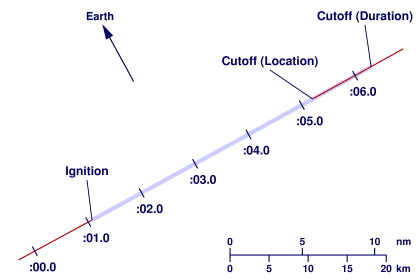
Times on the flight path are shown as seconds past 005:59:00 GET. The flight path before and after the burn is plotted in red. The flight path during the burn is shown in light blue.
Ignition occured at 005:59:01.07 GET (:01.07 on the plot). Cutoff occured at 005:59:06.30 GET (:06.30). However, the location at cutoff taken from the Mission report, Cutoff (Location), differs from the calculated location based on the burn figures, Cutoff (Duration). The difference between the two positions in space is 4.6 nautical miles [8.5 km]. The closest point to the Cutoff (Location) on the calculated burn flight path occurs at about 005:59:05.20 GET which is a distance of 0.1 nautical miles [0.2 km].
When similar calculations are performed for the later burns the Cutoff (Duration) and Cutoff (Location) points agree within the error limits. It is only the tiny, 5 second, SPS-1 burn that shows a large difference.
One possible explanation for the discrepancy is to note that in the Maneuver Summary table (Table 7-III in the Mission Report) the burn is listed with an ignition time 005:59:01.1 and a duration of 5.2 seconds. It is possible that when the Trajectory Parameters table (Table 7-II) was drawn up an incorrect value for the cutoff time was used (005:59:05.2 rather than 005:59:06.3) to calculate the position figures (latitude, longitude, altitude).
The spacecraft's position at cutoff after a burn duration of 5.23 seconds (converted back to Earth coordinates) is 29.55°N, 167.45°W, 108.7 nautical miles [201.3 km]].
005:59:06 Scott (onboard): Shutdown. Okay. Engine's shut off. The LM is still there, by God!
005:59:13 Schweickart (onboard): Okay -
005:59:15 Scott: Burn complete.
[The onboard transcription has this transmission by McDivitt.]
005:59:16 Schweickart (onboard): Okay, I want --
005:59:17 Roosa: Roger. Copy. Burn complete. [Long pause.]
005:59:18 Schweickart (onboard): -- to get the Delta-V thrust, off.
005:59:19 McDivitt (onboard): Delta thrust, off.
005:59:20 Schweickart (onboard): Okay. Verify all thrust-off cubes. Gimbal motors, four, to off, one at a time.
005:59:24 McDivitt (onboard): Okay. Pitch 1, off.
005:59:26 Schweickart (onboard): Verify.
005:59:27 McDivitt (onboard): Pitch 2, off.
005:59:28 Schweickart (onboard): Verify.
005:59:29 McDivitt (onboard): Yaw 1, off.
005:59:30 Schweickart (onboard): Verify.
[Onboard transcription break.]
005:59:42 Roosa: And, Apollo 9, Houston. I copy your residuals: plus 1.8, plus 0.5, minus 0.2.
005:59:48 Scott: Roger. That's affirmative. And the EMS was minus 4.2.
005:59:53 Roosa: Roger. Minus 4.2.
Public Affairs Officer - "Guidance Officer says a preliminary look indicates that it was a good burn."
[Comm break.]
006:02:52 Roosa: Apollo 9, Houston. In about 30 seconds we'll lose you off Hawaii and have you back at Redstone about a minute later. There will be a break in there, and then we'll pick you up for a long pass.
[Comm break.]
Public Affairs Officer - "We're 4 minutes away from the third S-IVB restart. The spacecraft will be over Guaymas but the S-IVB will be over Guam during this burn. We're showing through tracking now an S-IVB velocity of about 20,500 feet per second [6,250 m/s]. We expect to get a total velocity of 37,730 feet per second [11,500 m/s] as a result of this burn. We'll burn to escape trajectory."
Public Affairs Officer - "Showing the S-IVB in an orbit right now of 1,671 nautical miles [3,095 km] apogee, 115 and a half [nautical miles, 214 km] perigee."
[Communications have been switched to the tracking ship Redstone.]
006:05:18 Roosa: Apollo 9, this is Houston through Redstone. We ought to have you now on a long stateside pass. [Long pause.]
Public Affairs Officer - "And the duration of this burn will be 4 minutes."
006:06:17 Roosa: Apollo 9, Houston through Redatone. How do you read?
006:06:28 Scott: Houston, Apollo 9. How do you read?
006:06:31 Roosa: You're down a little bit, Dave, but I'm reading you okay. We've got you through the Redstone now, and it should be a nice long pass.
006:06:43 Scott: Houston, Apollo 9. You are unreadable.
006:06:46 Roosa: Roger. You're about the same. Stand by one here. I think we'll get better here in a couple of minutes.
[Comm break.]
Public Affairs Officer - "S-IVB ignition."
[S-IVB ignition occurred at 006:07:19.26 according to the Saturn V Evaluation Report.]
Public Affairs Officer - "Apogee just hit 3,000 [nautical] miles 5,500 km]. Velocity is up to 24,000 feet per second [7,300 m/s]]. 4,000 [nautical] mile [7,400 km] apogee, now. 5,000 [nautical] mile [9200 km] apogee, now. 6,000 [nautical] mile [11,000 km] apogee. Still burning and apogee has hit 8,000 [nautical] miles [14,800 km]. 10,000 [nautical] mile [18,500 km] apogee, now. And, we've lost data here on the S-IVB."
006:10:04 Roosa: Apollo 9, this is Houston. How do you read now? [Long pause.]
006:10:38 Roosa: Apollo 9, this is Houston. Trying again; how do you read?
[Comm break.]
Public Affairs Officer - "Flight Dynamics reports picking up a vector on the S-IVB which indicates a 53,000 [nautical] mile [98,000 km] apogee. Cut off."
[S-IVB cutoff occurred at 006:11:21.32 according to the Saturn V Evaluation Report.]
006:12:16 Roosa: Apollo 9, Houston. Do you read? [Long pause.]
[Communications have been switched to Texas.]
006:13:22 Roosa: Apollo 9, Houston through Texas. How do you read?
006:13:25 McDivitt: Roger. Houston, Apollo 9, We read you loud and clear. How about us?
006:13:28 Roosa: We're reading you five-square, We just sent the S-IVB hyperbolic and got it out of your way.
006:13:31 McDivitt: Very good. We were reading you all along there. I guess you just weren't reading us.
006:13:35 Roosa: Roger. Guess we had some of our receivers turned in on the S-IVB there, that I didn't know they had taken away from me.
006:13:47 McDivitt: Okay.
006:13:48 Roosa: When you get squared away after the burn, I've got your star count update for you.
006:14:13 McDivitt: Okay.
006:14:17 McDivitt: Okay, Houston. Go ahead with the update.
[The crew copies the update into the following form.]
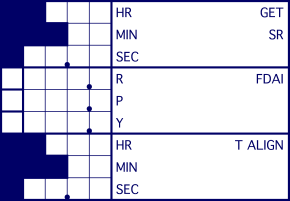
006:14:21 Roosa: Roger. Star count update: 006:49:45.00 068 - 068.0 if you want the decimal there - 291.1 330.2. End of update.
006:14:44 McDivitt: Roger, Understand. 006:49:45.00 068.0 291.1 330.2.
[An interpretation of the Star Check Update PAD is as follows:
Sunrise time - 15: GET 006:49:45.00. The time of the start of the daylight star check. The flight plan PAD describes this field as the time of sunrise at start of daylight star check. However, this figure is the start of the daylight star check procedure which is (sunrise - 15 minutes) and the crew interpret it correctly. Sunrise is thus predicted to occur at 007:04:45.00.
FDAI Angles: roll: +68.0°, pitch: +291.1° yaw: +330.2°. The gimbal angles for the spacecraft attitude.
Alignment time: Not required for this update.]
006:14:54 Roosa: That's affirmative. Houston confirms the update and would like to have you go ahead and open up the LM pressurization valve, if you concur.
006:15:04 McDivitt: Roger. We tried to get a hold of you before to tell you we're going to do it, so we'll open it up at this time.
006:15:10 Roosa: Okay.
006:15:25 McDivitt: Hoston, Apollo 9.
006:15:28 Roosa: Go, Apollo 9.
006:15:31 McDivitt: How are we making out on RCS as opposed to manual? What I'm wondering about is whether or not we should do the star count.
006:15:47 Roosa: Roger. Stand by one. [Long pause.]
006:16:30 Roosa: Apollo 9, Houston.
006:16:32 McDivitt: Go ahead.
006:16:34 Roosa: Roger. We're down a little bit, but we're got an excellent margin, and nobody is sweating it at all, Jim. We recommend that you go ahead and do this star check.
006:16:46 McDivitt: Okay. [Long pause.]
[Communications have been switched to Antigua.]
006:17:32 Scott: Houston, Apollo 9.
006:17:34 Roosa: Go, Houston.
006:17:37 Scott: Let me give you an up[date] on the SPS PU system there. Following the burn, I'm reading 89.2 percent in oxidizer and 93.7 in fuel and an unbalanced pegged on the decreased side.
006:18:02 Roosa: Roger. Copy 89.2, 93.7, and the unbalanced pegged on the decreased side.
[The Propellant Utilisation and Gauging System or PUGS allows the crew to monitor and optimize the usage of oxidizer and fuel to ensure full utilization of propellant.
A digital indicator displays the remaining percentage of oxidizer and fuel. Even though the oxidizer/fuel ratio is 1.6:1 the crew will attempt to ensure that the remaining percentage of each is the same.
The oxidizer unbalance indicator shows the unbalance of the remaining SPS propellants. The indicator needle at 0 indicates the correct propellant ratio. An upper indication shows that increased oxidizer flow is required. The lower half of the meter indicates decreased oxidizer flow is required. Dave has reported that the PU indicator is pegged on the decreased side as is suggested by the propellant percentages.]
006:18:10 Scott: Roger. And for your information, the feed vent, SPS injector valve A-1 opens slower than A-2.
006:18:22 Roosa: Roger. Copy. A-1 is slower than A-2.
[Long comm break.]
 |
 |
 |
| Separation & Ejection | Journal Home Page | Daylight Star Check |